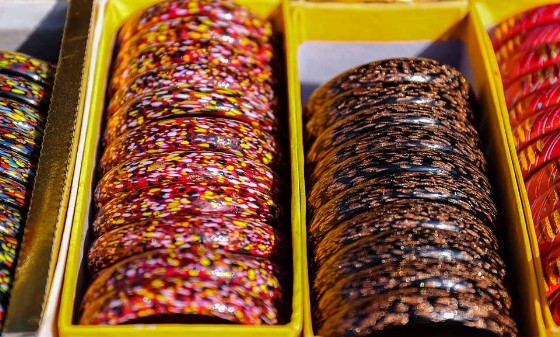Unveiling India's Artisans and Heritage: A Dive into Art & Craftsmanship
About India
In traditional Indian society, the shilpin (artisan, artist or craftsman) fashioned all the paraphernalia of life, be it a ritual object or a product of mere utility. Daily life was governed by the cycle of annual and seasonal rituals and by family celebrations such as conception, child birth, initiation, betrothal, marriage, death etc. For all these occasions an assortment of textiles and garments, vessels and utensils, toys, games, props and furniture were created by the artisans according to the religious and social conventions which determined their shape. For example, these could include a bronze-cast ritual lamp, a silver ladle, or a wooden rolling pin and plate with engraved geometrical designs to make a special kind of the thin Indian bread, or of a design for a textile. They ingeniously imbibed the village customs, personal care and sense of aesthetics and appropriateness of function and utility into their product. However, the same object used for mundane purposes attains a sacred value when used during a religious celebration which then elevated the craft and also its creator to the realm of the sacred.
The word Shilpa generally used in the Indian context for ‘any kind of art or craft’ originally meant ‘the art of variegating, diversified appearance’ implying India’s tremendous diversity in geographical regions, climate, languages and people adhering to widely different religions which are all reflected in its varied artistic materials, forms and expressions. The north-eastern regions, abundant in grasses, cane and bamboo, produce a variety of baskets, furniture, mats and ornamental jewellery; the coastal regions are rich in objects made of shells, coconut products, beautiful cotton and silk textiles; while in the scattered and dense forest belts, a wealth of ivory and timber are found, ideal for carving, engraving and the furniture industry. Colourful fabrics made of cotton, silk or mixed yarn, patterned while weaving by ikat technique, brocading or by using different coloured yarn; or after weaving by block-printing, embroidery or tinsel work, are found in each and every village, all over India.
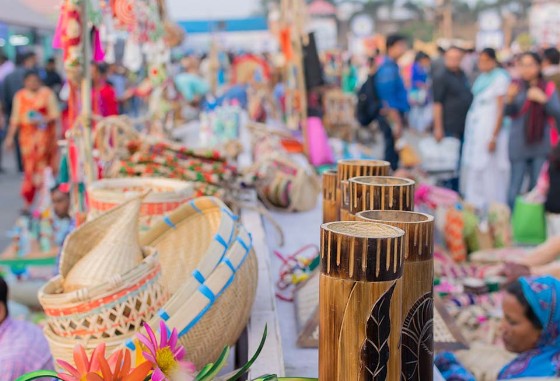
Descendants of the so-called tribal population living in the remote hilly tracts of the Indian subcontinent express themselves in unbound, spontaneous and often timeless artistic traditions incorporating their archaic myths, folklore and ritual customs. The forms and motifs of their wall paintings remind us of the prehistoric cave paintings; their technique of modeling of clay and casting of bronze or bell metal seem to be of the same manner as aeons ago. Foreign influences that came to the Indian region to stay brought with them their own cultural expressions which often caused an explosion of artistic forms. The superb calligraphy, floral motifs and style of painting of Islam were responsible for the outburst of textile designs, schools of miniature, costume patterns and also some new techniques, like for example bidri work and carpet weaving. They in turn adapted indigenous art forms for their regal paraphernalia while creating objects of jade, gold, silver, precious stones fashioned after the age-old techniques of terracotta, basketry or leather work. This melting pot of cultures created the endless variety of Indian art and craft traditions.
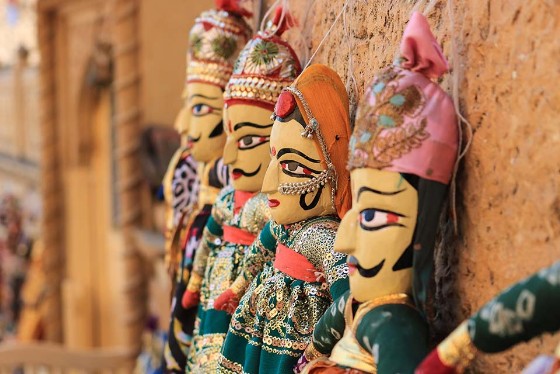
Sandalwood Carving
Sandalwood (Santalum album) is a small evergreen tree found allover the higher tracts of southern India. It is the most popular and expensive of all woods. It is engraved, inlaid or veneered, and shaped into a variety of ornate articles. The wood is not only used for carving and engraving, but also for making incense and perfume. The carvers, known as gudigars in South India, start their work either by drawing a pattern that is to be engraved on the smooth and whitewashed surface of the sandalwood, or on a piece of paper pasted over its surface. Then the outlines are engraved in minute detail, by cutting away the interspaces, thus leaving the pattern in low relief.
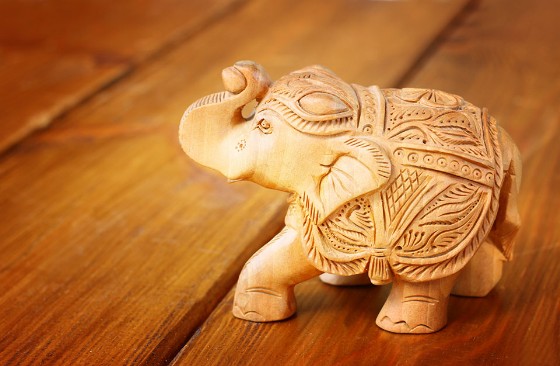
Carpet Weaving
The most productive region for carpet weaving in India is Kashmir. It is believed that this craft was not indigenous in India but was introduced by travelers or Haj pilgrims who were fascinated by the beautiful carpet traditions of Central Asia and Persia and wanted to bring these art forms back to India. The design of a carpet is governed by a module, the talim, which indicates the number governed by a module, the talim, which indicates the number of knots per square inch and the colour scheme along the weft line of wool or silk, while the wrap is always in cotton. Special types of carpets are produced in Ladakh woven in pure wool with cotton warp in fascinating colours with dragon, snow lion and lotus motifs. In the Chanthank area carpets, known as tsukdan, in both warp and weft in woolen yarn are made. Also, the Jammu region has carpet weaving centers. Carpet manufacture is now prevalent in most parts of the country.
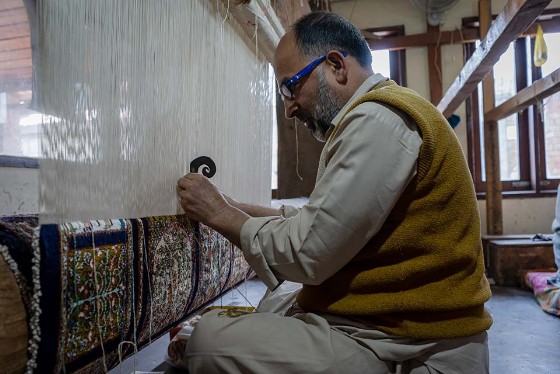
Gold Jewellery
Because of its precious value, gold has always evoked fascination. Its magic luster has been imbibed with auspiciousness. Every woman in India, regardless of the social strata or region she comes from, is desirous of ornamenting herself with golden ear-rings or nose-rings, armlets, wristlets, necklaces, bracelets, anklets, hairpins or other ornaments. The creative skills of traditional goldsmiths had no limits; ornaments are created in fine filigree work inOrissa or Andhra Pradesh; or heavy and richly worked ornaments from Gujarat and Rajasthan, or a rare work of art may be done in Pratabgrah in Rajasthan, wherein an effect of enamelling is achieved by fusing coloured substances onto gold (or other precious metals); and in the south a whole gamut of temple jewellery is created.
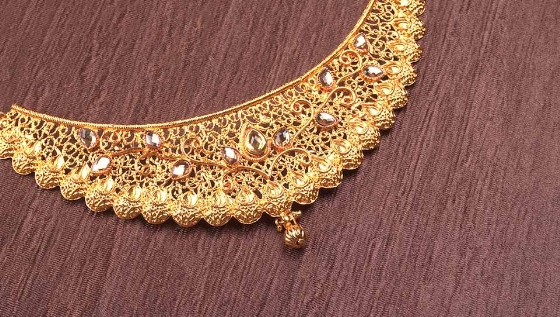
Block Priniting
In earlier times, Indian fabrics were dyed in natural dyes extracted from indigo leaves, al and turmeric roots, pomegranate skin, Katechu, lac, iron-rust, and the like. Around 1870, European chemical factories successes in synthesizing these natural substances causing great harm to these branches of handicrafts in India. However, with synthetic dyes it was impossible to achieve the brilliant luster for which the textiles from India were appreciated all over the world, since natural dyes penetrated the fabric completely via a lengthy process of beating, washing and sun-drying. A large variety of exquisite floor spreads, wall handing, tent panels, temple hangings. Ceiling cloths, coverlets, and canopies are created by block-printing, often in combination with hand painting in Machilipatnam, Kalahasti and other centers in the Andhra region; in Central India and in Rajasthan-specially in Sanganer and Bagru near Jaipur, where block printing is done with minute floral designs on basically plain white background: and in many centers in Gujarat, specially in Kutch, a fabric called ajrakh, a mainly dark blue-and-red printed cloth with geometric design is produced.
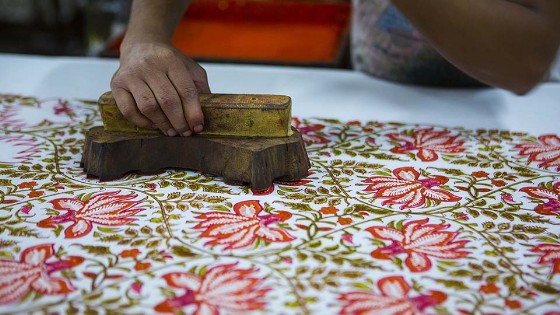
Lac Bangle Making
Because of its brilliant colours, lac, since very ancient times was considered the most suitable material for personal ornamentation for rural people. Most important is the manufacture of thin bracelets for rural girls and women all over India. Lac is basically a resinous incrustation formed on the bark of twigs of certain trees (kusum or pipal trees) through the action of the lac insect. After being impregnated, the female insect encrusts around itself a resinous excretion and then develops a brilliant red colour. Lac is available as dye in pure form or mixed with sulphur and formed into sticks called batti which are then used by lathe-turners.
